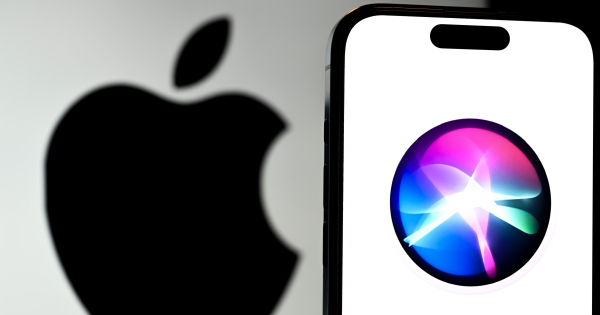
It would seem that who else but Apple should lead the AI revolution? The American company has been surprising the market with its breakthrough technologies since 1976. But in the case of AI, this has not happened. Forbes Ukraine has collected eight reasons from Bloomberg why Apple is failing to conquer artificial intelligence.
Entrepreneurs Forum 2025 in Kyiv. June 26–27 – two days of practical content, strategies, and networking for growing businesses. Join us at the link .
Apple is in a crisis in artificial intelligence. The company that set the tone for consumer technology for decades is now years behind its competitors. Inside the company, there is confusion, internal resistance and personnel changes, and outside, there is a loss of trust, lawsuits and disappointed users. All this is happening against the backdrop of the explosive growth of large language models at Microsoft, Google and OpenAI.
In 2018, the American tech giant Apple tried to catch up in the field of AI. At that time, its intelligent voice assistant Siri , which was supposed to be a breakthrough among AI assistants, was already inferior to Amazon’s Alexa and Google Assistant. Competitors’ voice assistants seemed much more advanced, while Siri had difficulty understanding basic commands, writes Bloomberg.
John Giannandrea, who led Google’s AI department and had helped scale AI into Google Photos, Gmail, and Google Translate, was called in to fix the situation. Now he was to head Apple’s artificial intelligence department.
It was a strategic strike against a competitor and at the same time a bet on a technological reboot of Siri.
Trying to catch up with competitors
Apple hoped Giannandrea would jumpstart the company’s transformation into an artificial intelligence giant. He would report directly to Apple CEO Tim Cook, putting AI on a par with software, hardware and services, Bloomberg notes.
Despite Giannandrea’s high expectations and talent, and his seven years at Apple, the company has never been able to take the lead in the AI race. The tech giant has lagged behind its competitors in both the speed of developing large language models and the actual implementation of AI features.
When ChatGPT blew up the AI market in 2022, Apple had little more than internal experiments with image generation and a test chatbot that were inferior to OpenAI Labs’ AI chat in accuracy, functionality, and scale. Instead of an AI breakthrough, there were constant delays, partial releases, instability of new tools, and massive frustration among developers, Bloomberg analyzes.
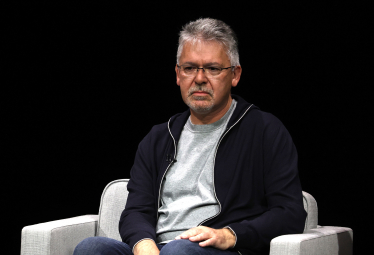
Apple had hoped that John Giannandrea would help the company catch up with competitors in the artificial intelligence market. But in his seven years at the company, that never happened. He led Apple’s AI department from 2018 to 2025. Photo: Getty Images
All hopes for Siri
Siri was supposed to be the centerpiece of Apple’s AI strategy – the main interface for users to interact with devices. Apple co-founder Steve Jobs, who died in 2011, saw it as more than just a question-and-answer system, but an “action engine” that would eliminate the need for users to manually search for information and use individual applications, Bloomberg notes.
Thus, Siri, based on artificial intelligence, became one of the parts of the Apple Intelligence package, which the company announced in June 2024 and positioned as “AI for the rest of us.”
Apple said that Siri will allow users to control their devices in new ways, such as selecting, cropping, and emailing photos to family members without touching the screen, Bloomberg reports.
The prospect of entering the market with AI-powered devices has sent Apple’s stock soaring. The hype began in September 2024, when the company announced that the new iPhone 16 was built entirely for Apple Intelligence. However, when the smartphone went on sale that same month, it did not have AI features, writes Bloomberg.
There was no Siri update, which Apple planned to release in April 2025, according to people working on the technology. The launch has been postponed indefinitely. And there is no talk of a full-fledged ChatGPT competitor from Apple yet, Bloomberg notes.
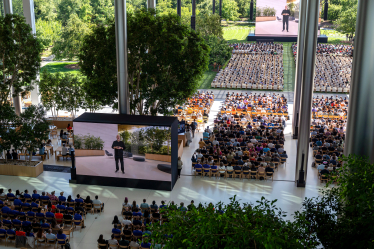
Apple Intelligence presentation at WWDC in June 2024. Photo by Getty Images
In the spring of 2025, Apple management effectively removed Giannandrea from the AI direction. He was left with only the scientific and research blocks, and according to Bloomberg sources, he may be on his way to a “soft retirement.”
Siri and other AI products were handed over to Mike Rockwell, who previously led the development of the Apple Vision Pro headset. Rockwell was supported by Craig Federighi, who is now responsible for the company’s overall AI roadmap.
After his appointment, Rockwell quickly reformatted the team, fired the previous leaders, and placed his deputies from the Vision Pro project in key positions.
This change signaled that Apple had acknowledged the systemic failure of its AI strategy. Here are eight reasons why it went wrong.
Too late and too slow
One of the main problems in the implementation of Apple’s AI products has been delays in the release of updates.
The company said the iPhone 16 was “built from the ground up” for Apple Intelligence, but when the device launched, it didn’t support the promised AI features. The first of these, including writing and summarizing tools, only arrived a month and a half later. Personalized Genmoji emojis only became available last December, and an iOS update to streamline notifications wasn’t released until March 2025.
Despite being late to innovation, this is not always fatal for Apple. The company often lets competitors take risks first, and then releases products that are more convenient for its billion-strong audience. This was the case with MP3 players, smartphones, tablets, watches and headphones, notes Bloomberg.
During a meeting with shareholders, Tim Cook explained these delays, highlighting the already available Apple Intelligence features and their localization in multiple languages.
Regarding Siri, he noted that the update is taking longer to reach high quality standards. “It’s just taking a little longer than we expected,” Cook said.
Internal resistance instead of ambition
Although Giannandrea reported directly to Tim Cook, his initiatives quickly ran into resistance from Craig Federighi, who didn’t see AI as a priority for the iPhone, Mac, and iPad and didn’t want to divert resources from operating system updates.
Some engineers at Apple thought AI should be a big part of the iPhone operating system. Back in 2014, they realized it was “a revolutionary technology, much more powerful than we initially thought,” but they couldn’t convince Federighi to take AI seriously.
“In AI, you don’t know what the product will be like until you invest in it. That’s not how Apple works,” one of the company’s top managers told Bloomberg.
The build-up to Apple Intelligence’s announcement at WWDC in June 2024 has forced the company to acknowledge its lag in generative AI. While Apple has already created basic images and tested an internal chatbot, its accuracy has lagged significantly behind ChatGPT, Bloomberg reports. The competitor was 25% more accurate for most queries.
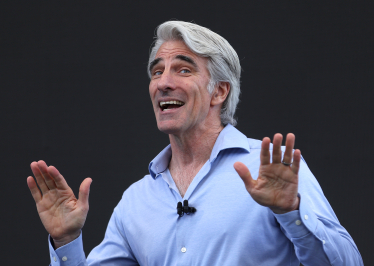
Apple software chief Craig Federighi. Photo by Getty Images
The difficulties of integrating into Apple’s corporate culture
Giannandrea saw Apple’s closed ecosystem as an advantage for AI, as it allowed him to quickly launch new features on billions of devices. However, he lacked the resources to test and train AI models. He managed to secure a budget and bring in experts from Google.
Many at Apple believe that the failure of Giannandrea’s initiatives is due to the difficulty of integrating him into the company’s tight-knit leadership circle, which has shaped its culture for decades.
Like many outside top managers, he failed to implement reforms in the company. Giannandrea was cautious, did not aggressively seek resources, did not pressure the team, and did not demand from them the fast pace that Apple was accustomed to, Bloomberg notes.
“Apple’s engineering teams are ‘do it, run it, get it done.’ John’s team is not like that,” one executive said. This was evident even in small ways, like free lunches for his team, even though other Apple employees pay for them themselves.
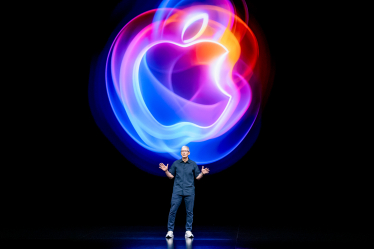
Apple CEO Tim Cook presents the new iPhone 16. Photo by David Paul Morris/Bloomberg via Getty Images
Promotion of not yet ready features
The failure to conquer AI cannot be considered solely Giannandrea’s fault, Bloomberg notes. He himself pointed to part of the responsibility of marketing under the leadership of Greg Jozwiak and Thor Myren, who promoted unfinished features. Product managers did not inform marketing about the real state of affairs, decisions on software were made by Craig Federighi, and the general approach was determined by Tim Cook himself.
In 2024, Apple announced new text editing tools and an updated Siri that was supposed to integrate user personal data for enhanced responses to queries. But a test iOS 18.4 on an iPhone 16 showed that key features were not working, although they were demonstrated at the WWDC conference as stable.
The release was first delayed to May 2025, then indefinitely. Advertisements for the iPhone 16 showed the AI features remaining, though not working. Some buyers joined class-action lawsuits accusing Apple of misleading them.
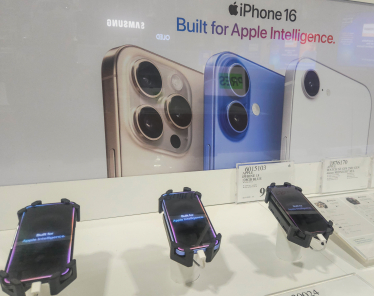
Apple claimed that the iPhone 16 was “built from the ground up” for Apple Intelligence, but when the device hit the market, it didn’t support the promised AI features.
AI is not part of Apple’s DNA
Apple became the most valuable tech company thanks to its methodical product launches with carefully curated content and infrequent updates. AI, on the other hand, is a more dynamic and chaotic industry.
Apple’s product success has historically been tied to technology developed in-house, but that formula hasn’t worked with AI. Last year, the company shut down its self-driving car project because its AI couldn’t deliver full self-driving capability.
Further failures in AI could jeopardize many projects, such as augmented reality glasses and robotic devices. Apple also risks being an outsider in the battle for a new format for interacting with digital devices.
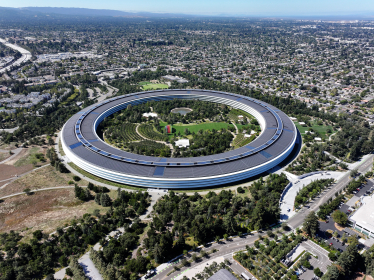
Apple headquarters in California, where the WWDC conference is held. Photo Getty Images
We missed the boom on the GPU
Former Apple CFO Luca Maestri’s conservative stance on purchasing GPUs, critical to the development of AI processors, now looks like a mistake. He didn’t want to buy them in large quantities upfront, like competitors. Instead, Apple used its market power and financial resources to shape global supply chains for components for manufacturing – from chips to glass for displays, writes Bloomberg.
But demand for GPUs has skyrocketed, outstripping supply. Apple’s cautious strategy of buying chips in small batches has led to Amazon and Microsoft buying up most of the chips available on the market. The GPU shortage has slowed Apple’s training of large language models significantly. “You can’t get more GPUs if your competitors have already taken everything apart,” says one member of the company’s AI team.
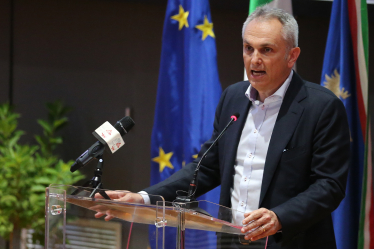
Apple CFO Luca Maestri at a meeting with Cisco Networking Academy graduates. Photo Getty Images
“Privacy Police”
Another obstacle is Apple’s privacy policy. The company has over 2.4 billion active devices, giving it access to vast amounts of data. But Apple is much stricter than Google, Meta, or OpenAI about allowing testers and developers to access personal user data. The company applies strict restrictions even to non-user data. Its Applebot scraper is easily blocked, and many sites have done so.
Because of limited access to data, Apple is forced to use commercial or synthetic datasets to train its language models. “For every ‘yes’ there are a thousand ‘no’s’, and you have to break through the ‘privacy police,’” a person familiar with the situation told Bloomberg. Another added: “X’s Grok language model is trained on all of X’s data. What will Apple learn from?”
Apple is now facing new challenges. The EU plans to allow users to replace Siri with third-party assistants. Without a breakthrough in AI, this could lead to a drain on users to OpenAI, Anthropic, Meta, and others.
Buying smaller AI companies instead of promising ones
Apple has been buying up dozens of small AI companies, such as Laserlike , Tuplejump , and Turi , to strengthen its position. The company even considered buying Mobileye Global Inc. for $4 billion, which would have been the largest acquisition in Apple’s history, accelerating the development of autonomous driving and computer vision technologies, and giving the company valuable AI talent. However, Apple declined, and Mobileye was acquired by Intel in 2017 for $15 billion.
Apple is looking at new partnerships with OpenAI and Anthropic as potential search providers for its Safari browser amid a slump in search queries. This is a sign of the growing use of assistants based on large language models to retrieve information. Google’s Gemini service, which Giannandrea has been trying to integrate into Siri in 2024, is planned as an alternative to ChatGPT in iOS 19. Apple is also in talks with startup Perplexity as a potential partner for Siri and search features in Safari.